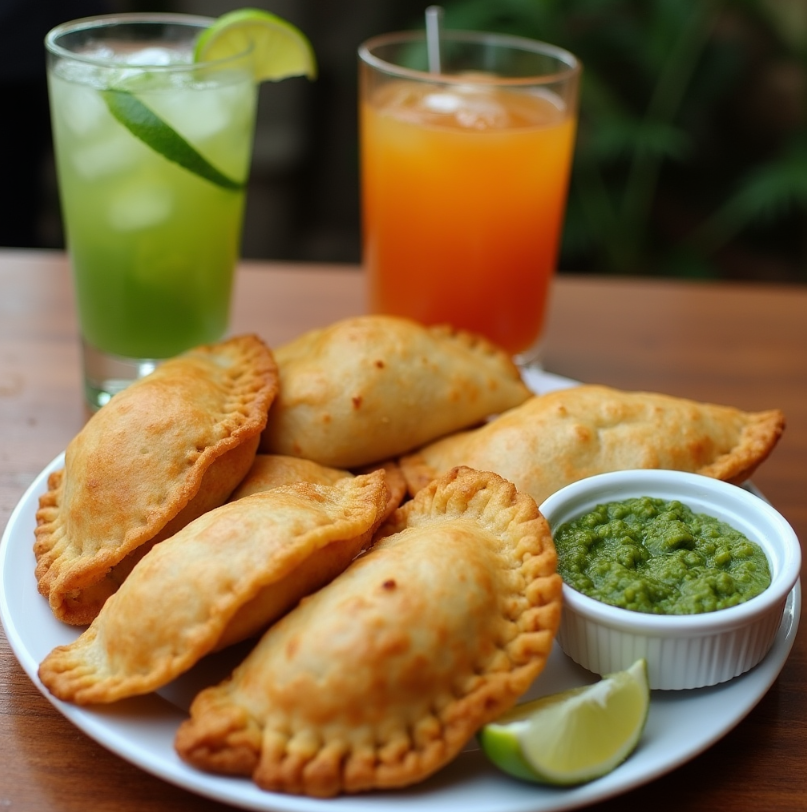When it comes to Venezuelan cuisine, few dishes hold the charm and widespread appeal of empanadas venezolanas. These golden pockets of deliciousness are a staple in homes, street food stands, and even gourmet restaurants across Venezuela. They’re not just food; they’re an experience. Whether you’re savoring them on a sunny morning with a cup of coffee or indulging in one as a midnight snack, empanadas venezolanas always hit the spot.
But what makes these empanadas so special? It’s not just the crisp, golden cornmeal crust or the flavorful fillings tucked inside. It’s the deep connection they have with Venezuelan culture, their history, and the creativity they inspire in every bite. In this article, we’ll dive deep into what makes empanadas venezolanas so irresistible and guide you step-by-step to make them at home.
What Are Empanadas Venezolanas?
Empanadas Venezolanas are the Venezuelan twist on a dish that’s popular across Latin America: empanadas. Unlike their wheat flour based cousins often found in other countries, Venezuelan empanadas are made with cornmeal dough, giving them a unique flavor and texture.
Imagine biting into a perfectly crispy shell that’s slightly sweet, with a tender inside brimming with your choice of savory fillings. From shredded beef and cheese to black beans and plantains, the variety of fillings is almost endless. They’re typically fried to perfection, though some modern recipes also explore baking for a healthier spin.
The History of Empanadas Venezolanas
The Cultural Significance of Venezuelan Empanadas
Empanadas in Venezuela are more than just a quick bite; they’re woven into the fabric of everyday life. Historically, empanadas have been a symbol of hospitality, where families gather to prepare them for festivals, celebrations, or casual gatherings. On bustling Venezuelan streets, you’ll find empanadas sold at every corner, a testament to their popularity.
Evolution of Ingredients Over Time
While traditional recipes still hold a special place, the ingredients used in empanadas venezolanas have evolved. Historically, fillings were simple: cheese, shredded beef, or chicken. However, as Venezuelan cuisine expanded and embraced global influences, so did the variety of empanadas. Today, you can find fusion versions with exotic flavors or even vegan and gluten-free options to cater to dietary needs.
Ingredients for Making Empanadas Venezolanas
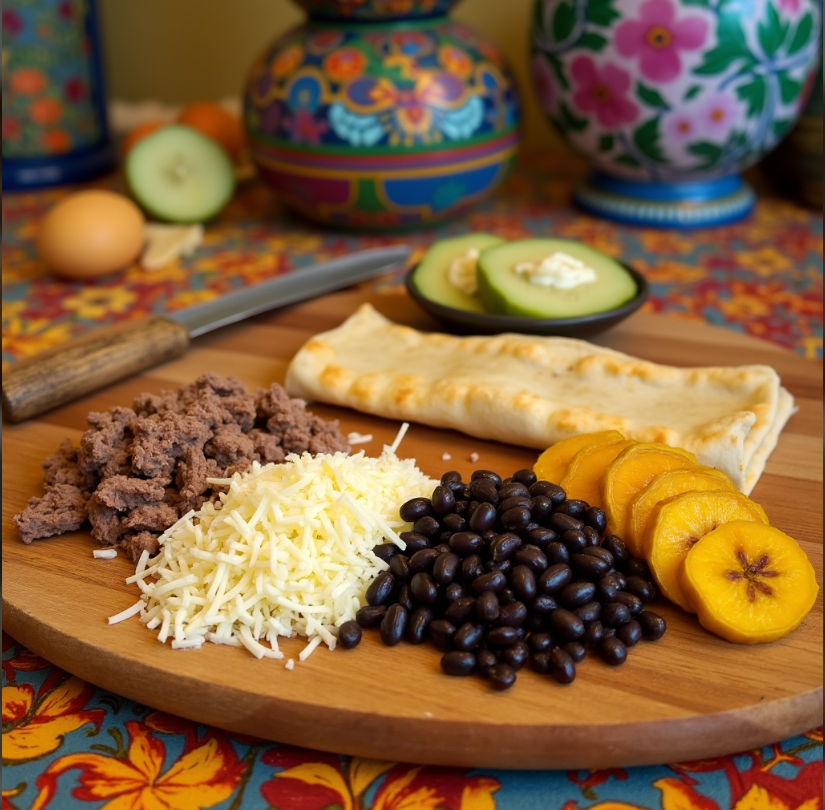
The Perfect Dough: Key Tips and Ingredients
The secret to a great empanada starts with the dough. Made from precooked cornmeal (harina de maíz), water, salt, and a touch of oil, the dough is simple but requires the right technique. Precooked cornmeal brands like Harina PAN are the go-to choice for achieving that authentic texture.
To get the best dough:
- Mix warm water with cornmeal and salt gradually, ensuring no lumps.
- Let the dough rest for a few minutes.
- Knead until smooth but not sticky—it should feel pliable, almost like modeling clay.
Traditional Fillings for Venezuelan Empanadas
The classic fillings are where empanadas truly shine. Some traditional favorites include:
- Carne Mechada: Shredded beef slow-cooked in a tomato-based sauce.
- Queso Guayanés: A creamy, salty cheese that melts beautifully.
- Pabellón Criollo: A mix of shredded beef, black beans, and sweet plantains inspired by Venezuela’s national dish.
Modern Twists on Classic Empanada Fillings
Want to add a little creativity? Modern Venezuelan chefs have experimented with international flavors like smoked salmon, spicy chicken curry, or even sweet fillings like Nutella or guava paste with cheese. The options are only limited by your imagination.
Step-by-Step Recipe for Empanadas Venezolanas
Preparing the Dough
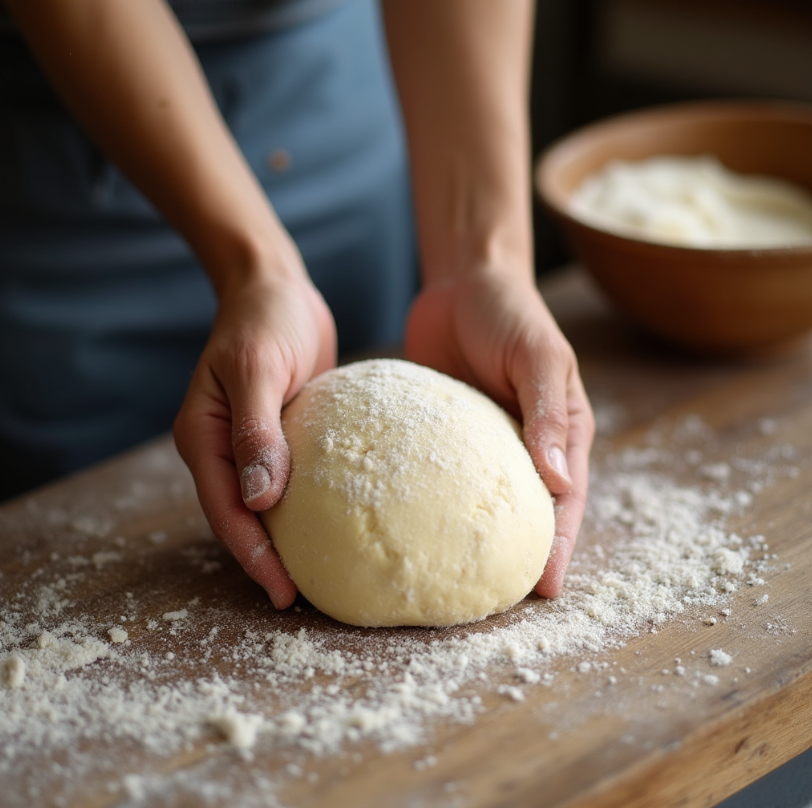
Start with the dough, as it forms the foundation of your empanadas. Combine 2 cups of precooked cornmeal, a teaspoon of salt, and 1.5 cups of warm water in a bowl. Mix until the ingredients come together, then knead lightly. The dough should feel moist but not sticky—add a bit more water or cornmeal as needed to get it just right.
Making the Fillings
Prepare your chosen fillings ahead of time. For example:
- Sauté shredded beef with onions, peppers, garlic, and tomato paste for a robust filling.
- Grate your favorite cheese, like mozzarella or queso fresco, for a quick and easy option.
- For a vegetarian filling, sauté diced plantains with black beans and a hint of cumin.
Cooking Methods: Fried vs. Baked
Traditionally, empanadas venezolanas are fried, resulting in a crispy golden exterior. Heat vegetable oil in a deep skillet and fry each empanada until golden brown, flipping once. Drain on paper towels to remove excess oil.
If you’re leaning toward a healthier option, brush your empanadas with oil and bake them in a preheated oven at 375°F (190°C) for 20-25 minutes, flipping halfway through. The result is slightly less crisp but still delicious.
Regional Variations of Empanadas Venezolanas
Coastal Flavors: Seafood-Filled Empanadas
Along Venezuela’s coastlines, seafood fillings reign supreme. Shrimp, crab, and fish empanadas are particularly popular, often seasoned with fresh herbs, lime, and a hint of spice.
Andean Influence on Empanada Recipes
In the Andean regions, empanadas take on a heartier twist. Fillings like potatoes, cheese, and even goat stew are common, reflecting the mountain culture’s reliance on robust, comforting foods.
Common Challenges When Making Empanadas Venezolanas
While making empanadas venezolanas is a rewarding culinary adventure, it’s not without its hurdles. Beginners often encounter a few common challenges, but don’t worry—these can be resolved with a bit of practice and know-how.
Troubleshooting Dough Consistency Issues
Getting the dough consistency right is perhaps the trickiest part. If the dough is too dry, it cracks during shaping, making it impossible to hold the filling. On the flip side, overly wet dough can become sticky and unmanageable.
Solutions:
- If your dough is cracking, add a tablespoon of water at a time and knead until smooth.
- For sticky dough, sprinkle in small amounts of cornmeal until it firms up.
Another tip? Let the dough rest for at least five minutes after mixing. This helps the cornmeal fully hydrate and makes the dough easier to work with.
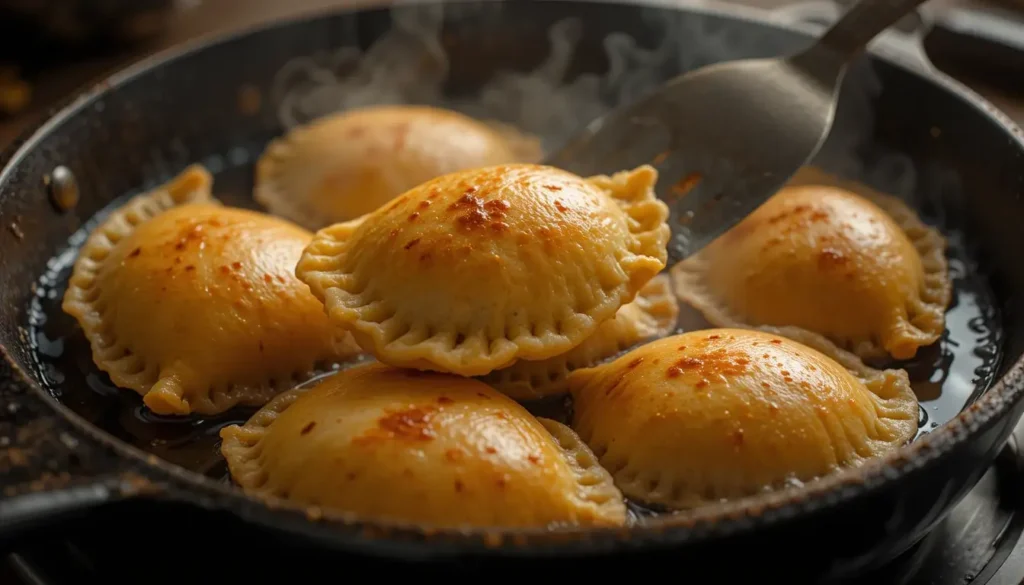
Avoiding Fillings Leakage During Cooking
One of the most frustrating problems is when your empanada fillings leak during frying or baking. This not only affects the appearance but also makes frying messy.
Solutions:
- Don’t overfill the empanada; a tablespoon or two of filling is usually enough.
- Seal the edges firmly by pinching the dough or using a fork to create ridges.
- If the dough tears, patch it by pressing a small piece of dough over the hole.
Why Are Empanadas Venezolanas So Popular?
Empanadas are more than just food—they’re a cornerstone of Venezuelan culture. They’re cherished for their versatility, ease of preparation, and ability to bring people together, whether it’s at a family breakfast or a bustling street food market.
Their Role in Venezuelan Street Food Culture
In Venezuela, empanadas are a staple of the vibrant street food scene. Vendors across the country set up small stands called “empanaderas,” offering freshly made empanadas to passersby. Whether you’re in the busy streets of Caracas or a quiet coastal village, you’ll find locals indulging in these savory treats.
The street food experience often includes empanadas served with dipping sauces like guasacaca (a tangy avocado-based sauce) or spicy garlic sauce, elevating the flavor to new heights.
The Versatility of Empanadas for Any Occasion
One reason for their popularity is their sheer adaptability. Empanadas can be enjoyed as breakfast, lunch, or dinner. They’re perfect for a quick snack on the go or as a centerpiece for a party platter. Want to surprise guests with a unique appetizer? Miniature empanadas make for an elegant, bite-sized treat.
Nutritional Value of Empanadas Venezolanas
While empanadas aren’t traditionally considered health food, there’s a lot to appreciate in terms of their nutritional makeup. They can be a balanced meal, depending on how they’re prepared and what they’re filled with.
Balancing Flavor and Health
Empanadas are rich in carbohydrates from the cornmeal dough, providing a good source of energy. The fillings—especially if you include proteins like chicken, beef, or beans—offer essential nutrients. Adding vegetables to your fillings is an easy way to boost the fiber and vitamin content of your empanadas.
Tips for Healthier Empanada Variations
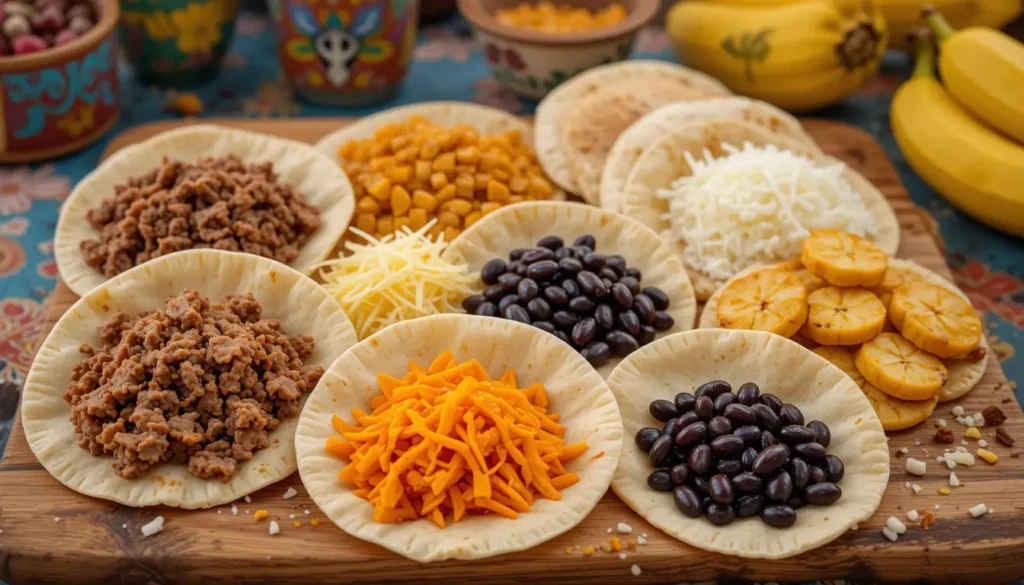
If you’re looking to make your empanadas a bit healthier, here are some tips:
- Use lean proteins like shredded chicken breast or turkey.
- Incorporate nutrient-dense fillings, such as spinach, mushrooms, or sweet potatoes.
- Opt for baking instead of frying to cut down on fat and calories.
With these tweaks, you can enjoy empanadas venezolanas guilt-free while maintaining their authentic flavor.
Pairing Ideas: Drinks and Sauces for Empanadas Venezolanas
No empanada experience is complete without the right accompaniments. Drinks and sauces can transform your meal, taking the flavors to the next level.
Traditional Venezuelan Beverages
When it comes to drinks, nothing pairs better with empanadas venezolanas than classic Venezuelan beverages. Some popular options include:
- Chicha: A sweet, creamy rice-based drink, perfect for balancing the savory flavors of empanadas.
- Papelón con Limón: A refreshing blend of raw sugar cane and lime, offering a tangy counterpoint to the rich empanadas.
- Café con Leche: Venezuelan coffee with milk, ideal for a breakfast empanada.
The Best Dips and Sauces
Dips can make or break your empanada experience. While empanadas are delicious on their own, pairing them with the right sauce can enhance their flavor profile.
- Guasacaca: A Venezuelan avocado sauce that’s tangy, creamy, and slightly garlicky.
- Ají Picante: A spicy chili sauce for those who love a little heat.
- Sour Cream or Yogurt: For a lighter, cooling contrast to the fried empanada.
Experiment with different sauces to find your favorite combination!
How Empanadas Venezolanas Are Celebrated Globally
The love for empanadas venezolanas has spread far beyond Venezuela, making them a celebrated dish in many countries.
Empanada Festivals Around the World
Empanada festivals are common in areas with a strong Venezuelan presence, such as Miami, Madrid, and Buenos Aires. These events are a fantastic way to sample regional variations, try new fillings, and enjoy the festive atmosphere that empanadas inspire.
Venezuelan Empanadas in International Cuisine
As Venezuelans migrate around the globe, they bring their culinary traditions with them. Empanadas are increasingly featured in international restaurants, where chefs often fuse traditional recipes with local ingredients, creating exciting new versions.
To inspire modern variations, consider incorporating ideas from What to Make with Turkey Sausage: Delicious and Versatile Recipes for Every Meal. Turkey sausage could provide a lighter yet equally flavorful twist on the classic empanada filling.
Tips for Storing and Reheating Empanadas Venezolanas
One of the many joys of making empanadas venezolanas is that they store beautifully, allowing you to enjoy them days later. However, storing and reheating them properly is key to preserving their texture and flavor.
Proper Storage Methods for Freshness
To keep your empanadas fresh, here are some best practices:
- Refrigeration: If you’re planning to eat your empanadas within a few days, store them in an airtight container in the refrigerator. Place parchment paper between layers to prevent sticking.
- Freezing: For longer storage, empanadas can be frozen. Arrange uncooked or cooked empanadas on a baking sheet in a single layer and freeze until solid. Once frozen, transfer them to a freezer-safe bag or container. They’ll stay fresh for up to 3 months.
Reheating Techniques to Retain Crispiness
Reheating empanadas is an art—nobody wants a soggy crust!
- Oven Method: Preheat your oven to 350°F (175°C). Place the empanadas on a baking sheet and heat for 10–15 minutes, flipping halfway through. This ensures even crisping.
- Air Fryer: An air fryer is ideal for reheating empanadas. Set it to 325°F (160°C) and heat for about 5–8 minutes.
- Stovetop: Heat a skillet over medium heat, adding a small amount of oil. Reheat the empanadas for a few minutes on each side.
Avoid microwaving unless you’re in a hurry, as it tends to make the crust rubbery.
Empanadas Venezolanas: A Symbol of Community and Celebration
Empanadas have always been more than just food in Venezuela. They symbolize warmth, family, and togetherness.
How Empanadas Bring People Together
In Venezuelan households, making empanadas is often a group activity. Family members gather to prepare the dough, assemble the fillings, and fry or bake together. It’s not just about the final product—it’s about the shared laughter, stories, and memories created in the process.
Sharing the Joy of Empanadas Across Cultures
As Venezuelans move to different parts of the world, they bring their love for empanadas with them, sharing this iconic dish with new friends and communities. Empanadas often become the centerpiece of potlucks, cultural festivals, and celebrations, breaking down cultural barriers and connecting people through food.
FAQs About Empanadas Venezolanas
What makes empanadas venezolanas different from other types of empanadas?
The key difference lies in the dough. Venezuelan empanadas are made with cornmeal, giving them a unique flavor and texture that sets them apart from the wheat-based empanadas of other countries.
Can empanadas venezolanas be baked instead of fried?
Yes! While frying is traditional, baking is a healthier option. Just brush the empanadas with oil and bake them at 375°F (190°C) for 20–25 minutes until golden brown.
What’s the best way to seal empanadas to prevent leaks?
Use your fingers to pinch the edges firmly, or press them with a fork to create a tight seal. For extra security, wet the edges of the dough slightly before sealing.
Can I make empanadas venezolanas gluten-free?
Absolutely! Traditional empanada dough is already gluten-free since it’s made with cornmeal. Just make sure your cornmeal is certified gluten-free to avoid cross-contamination.
What’s the most popular filling for empanadas venezolanas?
Shredded beef (carne mechada) is a classic favorite, but cheese and black beans are also widely loved.
How do I prevent empanadas from getting soggy?
Ensure your fillings are not too wet and avoid overfilling. When frying, make sure the oil is hot enough (around 350°F/175°C) to create a crispy crust quickly.
Final Thoughts on Empanadas Venezolanas
Empanadas venezolanas are more than just a dish—they’re a cultural treasure that brings people together, whether it’s at a family breakfast, a bustling street food market, or a festive celebration. From their rich history and regional variations to their adaptability and global appeal, empanadas are a testament to the creativity and warmth of Venezuelan cuisine.
So, why not try making a batch of empanadas venezolanas yourself? With a little practice and the right ingredients, you’ll be able to recreate this beloved dish in your own kitchen. And who knows? It might just become your new go-to recipe for every occasion!

